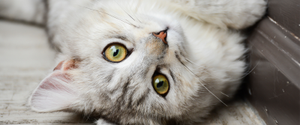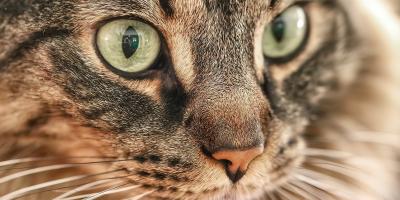
Is Catnip Bad for Cats? Understanding Why Cats Love Catnip

From darting around the house to rolling in the herbaceous scent, your cat's reaction to catnip is as individual as she is. Your fluffy friend may love the stuff, or she could be indifferent to its effects. Knowing how catnip works can help you understand your own feline companion better, and it can give you a safe, fun way to make her day.
What Is Catnip?
The scientific name for catnip is Nepeta cataria. It is classified as a herb in the mint family, so catnip is related to peppermint and spearmint. While it originated in Asia and Europe, catnip is now grown all over the world. Whether it is in a home garden or growing wild alongside country roads, this plant is almost irresistible to many felines.
You can grow catnip yourself to give the fresh version to your pet, but most commercial catnip is found in a dried and crushed form. Fresh catnip is more potent than the dried version, so you can use less of it to get a similar effect.
How Does Catnip Work?
Catnip produces an organic compound called nepetalactone, which enters a cat's system through the nasal passages. Nepetalactone is found in microscopic bulbs in the leaves, stem and pods of the catnip plant, and the compound gets released when the plant is crushed or chewed. A cat rubbing against fresh or dried pieces of the plant can also release the nepetalactone.
Once your cat inhales nepetalactone, the molecules bind to olfactory cells in her nose, which sends a signal to her brain that makes her go wild.
Why Do Cats Love Catnip?
Cats love catnip because it makes them feel good. As your cat licks and rubs on the herb, the release of nepetalactone sets off a euphoric reaction. Scientists aren't sure exactly why this happens, but many believe cats are responding to the nepetalactone as though it is a pheromone.
How Do Cats React to Catnip?
The first thing many owners notice when giving their cat some catnip is that they start acting in ways that help release nepetalactone. You might see your cat roll in a patch of catnip or start trying to eat it to get more into her system.
As the catnip hits her system, your cat might become hyperactive, running around the room and jumping on furniture or a favourite cat tree. Some cats start stretching and drooling while rolling around on the floor. Other cats have a more sedated reaction, becoming calm and relaxed after inhaling the potent scent of catnip. Essentially, the effects are different for each cat, so you can't predict exactly how your pet might respond until you let her experience the joys of catnip for herself.
How Long Do the Effects of Catnip Last?
Whether your cat becomes extra energetic or lounges in a patch of catnip in lazy appreciation, the effects of catnip only last a short while. Most cats return to normal behaviour within a half hour, and many only experience strong effects for 5 to 10 minutes. Cats also become temporarily immune to the effects after calming down, so giving your cat more doesn't inspire the same bizarre cat behaviour.
Do All Cats Respond to Catnip?
Not all cats react to catnip. About 30 percent of domestic house cats don't have a reaction at all. Kittens and senior cats don't tend to react as strongly as adult cats. In fact, young kittens typically don't experience any reaction at all. Kittens only start to react to catnip once they reach 3 to 6 months of age.
The tendency to react to catnip at all seems to be genetic, so an apparent immunity to the effects can be passed down through generations.
Other species of cats do react to catnip, though. Lions and tigers have been known to succumb to the allure of this decadent feline-attracting herb.
Is Catnip Bad for Cats?
There is no evidence that catnip is toxic to cats, although some cats have an adverse reaction, particularly if they eat the catnip instead of just sniffing it or rolling in it. If you notice vomiting or diarrhea after ingesting catnip, consult a vet.
Because the effects wear off fairly quickly and cats develop a temporary immunity to it after a half hour or so, there is no real risk of overdose. If you give your cat catnip often, you might notice decreased effects, so it's a good idea to save the catnip for special occasions.
How Should You Give a Cat Catnip?
You can rub catnip on a cat toy to encourage your feline friend to get more exercise through active play. There are also catnip toys available that have a pouch inside to place fresh catnip before you initiate a play session. Using catnip to make your cat more active is a good way to help your overweight feline lose weight.
Catnip on a scratching post captures your cat's attention and can entice her to scratch there instead of on your furniture. Catnip-flavoured cat treats make a great reward or training aid for your active feline companion.
If catnip has a calming effect on your fuzzy friend, you can use it as a gentle sedative to relax your cat when travelling in a car or meeting a new addition to your household. Simply sprinkle some catnip inside her carrier or in her favourite napping spot before the potentially stressful event.
When you're introducing your cat to catnip for the first time, only give a small amount to see how she responds. Watch for any adverse reactions and base the amount you give on how strong of a reaction she has.
Does Catnip Affect Humans?
Humans don't react to catnip in the same way felines do, but people sometimes use the herb as an alternative remedy for conditions such as migraines, insomnia and arthritis. Catnip also works as a gentle insect repellent, though it tends not to be as long-lasting or effective as traditional mosquito repellents.
Related articles


